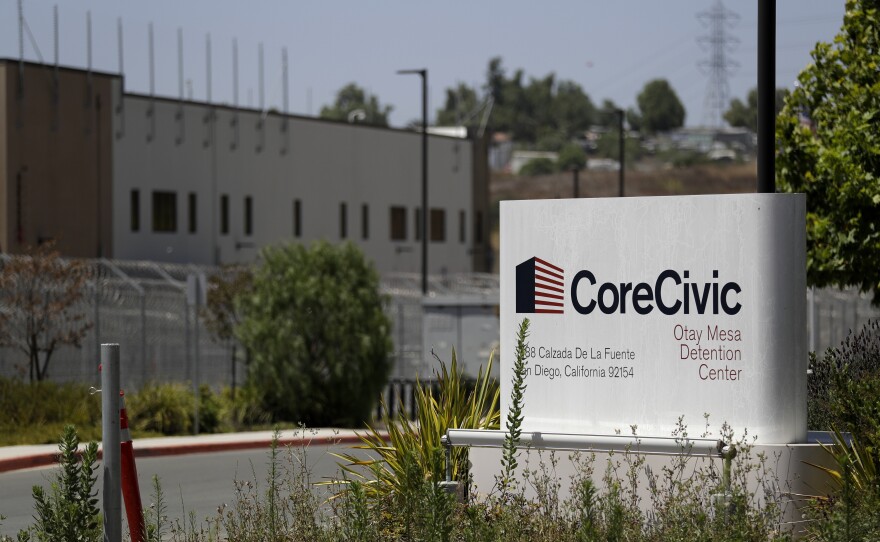This is part one of a two-part series.
Imagine being arrested in a raid and thrown in jail. You’re granted a hearing and the judge agrees to release you on bond. But even though you pay the bond, you stay in jail.
This nightmare scenario happened to a 49-year-old Mexican in late June. He’s been in this country for 26 years, owns a construction business and is the father of a United States citizen son, according to court documents filed by his lawyer Mitchell Shen.
Immigration and Customs Enforcement (ICE) agents placed the man, who Shen asked KPBS to identify only as Mr. C, in the Otay Mesa Detention Center. After nearly a month in custody, an immigration judge granted his release on a $3,000 bond that his family paid on July 14.
Under previous administrations, people fitting Mr. C’s profile — deep family ties, no flight risk, and no violent criminal record — would have been quickly released and allowed to fight their deportation case from home.
But the Trump administration kept him locked up two weeks after his family paid bond, according to Shen. So Shen played the only card he had left: A federal lawsuit known as a writ of Habeas Corpus petition seeking Mr. C’s release.
Have a tip? 📨
The Investigations Team at KPBS holds powerful people and institutions accountable. But we can’t do it alone — we depend on tips from the public to point us in the right direction. There are two ways to contact the I-Team.
For general tips, you can send an email to investigations@kpbs.org.
If you need more security, you can send anonymous tips or share documents via our secure Signal account at 619-594-8177.
To learn more about how we use Signal and other privacy protections, click here.
Habeas Corpus has been part of U.S. law since the founding of the country. Simply put, it’s a person’s last line of legal defense against illegal detention.
Historically Habeas petitions have rarely been used in immigration cases. But they’ve skyrocketed during the early months of President Donald Trump’s second term. Mr. C’s petition is just one of more than 3,300 filed in district courts across the country this year.
Each case accuses the federal government of subjecting immigrants to illegal and prolonged detention.
“ICE’s continued detention of (Mr. C) without bond, despite the (immigration judge’s) determination constitutes an unlawful deprivation of liberty and creates a risk of unlawful, prolonged detention,” Shen wrote in the Habeas petition.
Historic surge
Lawyers, academics and retired immigration judges told KPBS that they have never seen such a dramatic increase in Habeas petitions coming out of the immigration court system. The numbers have jumped dramatically in just the past two months.
For example, in the U.S. Southern District of California, lawyers filed just one Habeas petition in January and one in February. But the same court, which covers San Diego and Imperial counties, received nearly 40 petitions in September and more than 60 in October.
“In 50 years, this has never occurred at this level,” said Dana Marks, a retired immigration judge in San Francisco.
Previously, immigration lawyers have been able to work within the immigration court system to release their clients from custody — either by asking an immigration judge for a bond hearing or asking ICE for parole.
But Trump administration officials have eliminated those options for most people in detention.
“In a normal year, I’ll file one or two,” said Stacy Tolchin, a Pasadena-based immigration lawyer. “I’ve been filing three a week since September.”
Done by design
The Habeas petitions are in essence a roadmap of how the Trump administration has quietly rewritten our country’s immigration rules, lawyers and other advocates said.
“They’re using detention to make it harder for people to fight their cases, to fight their deportation,” said Cassandra Lopez, an immigration lawyer with the immigrant rights group Al Otro Lado who has filed several Habeas petitions.
The indefinite detentions are done by design — to pressure people into self deporting, Lopez and others said. Data from the immigration court system suggest this strategy is working.
In August, more than 6,000 deportation cases ended with “voluntary departures.” This is the most ever for a single month, according to data from Syracuse University’s Transactional Records Access Clearinghouse (TRAC), which goes back to 1997.
Similarly, immigration judges denied more than 8,000 bond hearings in July — also the most ever recorded in a single month, according to TRAC data.
“As far as other options on how to get our clients out, there really aren’t any,” said Nerea Sholl-Woods, a San Diego-based immigration lawyer.
In response to questions from KPBS about the administration’s tactics and the surge in Habeas petitions, Department of Justice spokesperson Natalie Baldassarre provided the following statement:
“President Trump and the Department of Justice will continue to enforce the law as it is written to defend and protect the safety and security of the American people.”
Viral videos of chaotic immigration raids in Los Angeles and Chicago have shown the public what mass arrests look like. But what happens after the arrests has largely been kept behind closed doors.
The Habeas petitions offer a fuller picture of the lives of those caught up in the deportation machine, and a peek behind the closed doors of immigration detention centers.
Those seeking petitions include husbands of U.S. citizen wives and mothers of U.S. citizen children. Others feature business owners with no criminal records, asylum seekers fleeing Taliban rule and grandparents with pre-existing medical conditions that aren't being treated in detention centers.
In Habeas cases where immigrants have criminal records, they are for nonviolent offenses that happened decades ago.
The court documents paint an antithetical picture to the Trump administration’s narrative that mass deportations prioritize dangerous and violent criminals.
“I think people need to remember who an immigrant is,” Sholl-Woods said. “It’s your neighbor, it’s a student, it’s your kid’s friend at school. They bring something to our community.”
There is an irony to the origins of Habeas Corpus in the U.S. and how it’s being used today. During the Revolutionary War, British troops used general warrants to conduct sweeps of people’s homes without probable cause and throwing people in jail without granting them a hearing for their release.
“Our Constitution reflects exactly what was going on in the colonies and the concerns that the Founding Fathers had about a new government having the same kinds of powers,” said Justin Brooks, a law professor at the University of San Diego and co-founder of the California Innocence Project.
Now, nearly 250 years later, immigration lawyers are using Habeas petitions in a similar spirit.
“The King cannot just throw you into a dungeon in the United States,” Lopez said. “We have the Habeas Corpus provision that allows us to ask a court to find that we’re being held in violation of the law.”

Board of Immigration Appeals
To understand how the Trump administration is able to re-write the rules of immigration court, it is important to understand how that system is set up.
Unlike federal courts, which are part of the judicial branch, immigration courts operate under the executive branch. That means political appointees have broad powers to influence how the court operates. For example, U.S. Attorney General Pam Bondi has the authority to hire and fire immigration judges
She also appoints people to the Board of Immigration Appeals (BIA). This is a little-known part of the immigration court system that directs judges on how to interpret immigration law.
So far this year, the Trump administration has fired more than 100 immigration judges. Marks said her former colleagues feel like there’s a target on their backs.
“Morale has never been worse,” said Marks. “Judges are terrorized by the sword hanging over their heads as to whether or not they’re going to be fired.”
Marks had a 10-year career as an immigration lawyer before becoming a judge. On the bench, she made a point to recruit more people from private practice because the majority of immigration judges were former prosecutors.
“I can’t recommend that job to anybody anymore,” she said.
In response to criticisms about BIA decisions, Baldassarre, the DOJ spokesperson, said the federal government is, “Restoring integrity to the immigration adjudication system, and the BIA decisions reflect straightforward interpretations of clear statutory language.”
Having political appointees decide who can be a judge and how those judges interpret law creates an unfair system of justice, said Noll-Woods.
“That would not happen in an independent court system,” she said.
Also, the BIA and Bondi do not rely on case law to establish precedent like state and federal judges do. It has the authority to pick an individual decision from one immigration judge and apply it to all future cases by publishing, “precedent decisions.”
For example, if an immigration judge in one state decides that a certain category of immigrants, like migrants who entered the country via Biden-era parole programs, are no longer eligible for bond, the BIA can force every judge in the country to follow that decision, the lawyers say.
“The fact that the (BIA) can have their cases cherry-picked by the Attorney General means that policy of a particular administration begins to encroach on the substantive law,” Marks said. “We are being reduced to being judges in name only."
For example, a September decision explicitly said, “Immigration judges lack authority to hear bond requests or grant bond to aliens who are present in the United States without admission.”
“It is so calculated,” said Tolchin. “It’s a disincentive for anyone to fight their case. Who wants to fight their case when you’re going to be detained for a year or more?”
- Grossmont schools already feeling impacts of library cuts
- Records: El Cajon license plate data used in nationwide immigration searches
- CA Attorney General sues El Cajon over license plate reader data, following KPBS story
- Animal shelter supervisor ‘out of the office’ after revelation of profane recording







